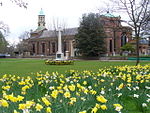Kew Mortuary
Buildings and structures in the London Borough of Richmond upon ThamesHistory of the London Borough of Richmond upon ThamesKew, LondonKew GreenUse British English from June 2019

The Kew Mortuary or Dead-House is a small, shed-like building, approximately 3.75 by 2.25 metres (12.3 ft × 7.4 ft) and 2.8 metres (9 ft 2 in) high, attached to the back of Caxton House, 110 Kew Green (TW9 3AR), just to the east of Kew Bridge on Greyhound Lane facing Westerley Ware. This Victorian mortuary building retains an original slate slab.
Excerpt from the Wikipedia article Kew Mortuary (License: CC BY-SA 3.0, Authors, Images).Kew Mortuary
Kew Green, London Kew (London Borough of Richmond upon Thames)
Geographical coordinates (GPS) Address Nearby Places Show on map
Geographical coordinates (GPS)
| Latitude | Longitude |
|---|---|
| N 51.485602777778 ° | E -0.28708888888889 ° |
Address
Kew Green 110
TW9 3AP London, Kew (London Borough of Richmond upon Thames)
England, United Kingdom
Open on Google Maps









